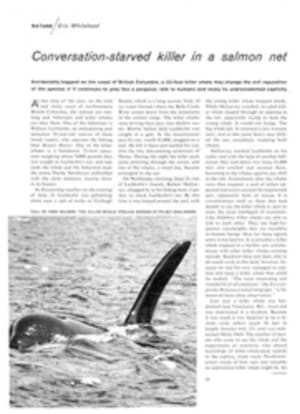
Conversation-starved killer in a salmon net
At this time of the year, on the wild and rocky coast of northwestern British Columbia, the salmon are running and fishermen and killer whales are after them. One of the fishermen is William Lechkobit, an enterprising and tenacious 28-year-old veteran of these lonely waters, who operates the fishing boat Bounty Hunter. One of the killer whales is a handsome 22-foot specimen weighing about 9,000 pounds that was caught in Lechkobit's net, and last week the whale and the fisherman kept the entire Pacific Northwest enthralled with the most dramatic marine show in its history.
In threatening weather on the evening of June 22 Lechkobit was gillnetting alone near a spit of rocks in Fitzhugh Sound, which is a long narrow body of icy water formed where the Bella Coola River comes down from the mountains of the coastal range. The killer whales were driving their prey into shallow water. Shortly before dark Lechkobit was caught in a gale. In the mountainous seas his net, worth $1,000, snagged on a reef. He left it there and battled his way into the tiny fish-canning settlement of Namu. During the night the killer pack came prowling through the waves, and one of the whales, a small one, became entangled in the net.
On Wednesday morning, June 23, one of Lechkobit's friends, Robert McGarvey, chugged by in his fishing boat, Cape Sun, to check Lechkobit's net. By this time it was looped around the reef, with the young killer whale trapped inside. While McGarvey watched, an adult killer whale slipped through an opening in the net, apparently trying to help the young whale. It would not budge. The big whale left. It returned a few minutes later, and at this point heavy seas shifted the net, completely trapping both whales.
McGarvey reached Lechkobit on his radio, and with the help of another fisherman they laid down two more $1,000 nets and cinched and secured them, hemming in the whales against any shift in the tide. Immediately after the whales were thus trapped, a pod of killers appeared and swam around the imprisoned pair, apparently bent on rescue. It is circumstances such as these that lead people to say the killer whale is, next to man, the most intelligent of mammals. Like dolphins, killer whales are able to talk to each other. They use high-frequency wavelengths that are inaudible to human beings. How far these signals carry is not known. It is possible a killer whale trapped in a harbor can communicate with other killer whales cruising outside. Scientists have not been able to do much work in this field, however, because no one has ever managed to capture and keep a killer whale that could be studied. "The most interesting and wonderful of all creatures," the Encyclopaedia Britannica noted long ago, "is far removed from close observation."
Last year a killer whale was harpooned near Vancouver, B.C., lived and was imprisoned in a drydock. Because it was small it was believed to be a female—male killers reach 30 feet in length, females only 15—and was nicknamed Moby Doll. The number of people who came to see the whale and the experiments of scientists, who played recordings of killer-whale-pack sounds to the captive, made many Northwesterners aware of how rare and valuable an imprisoned killer whale might be. Its value became even more evident when Moby Doll, which finally turned out to be a male, died after 87 days in captivity. Lechkobit and McGarvey knew that they had a valuable marine specimen in their nets and that an unusual and interesting ethnological demonstration was going on in the behavior of the pack of killer whales swimming around it.
The question was: How could they profit from the accidental capture? They hurried to Namu and put in telephone calls to marine authorities up and down the coast, offering two killer whales for sale for $50,000. However, anyone who has ever tried to use the marine telephone communication among the islands of British Columbia will see the impracticality of their efforts, since the system is as mysterious as the high-frequency speech of whales and dolphins. So it was that Lechkobit and McGarvey found no takers when they offered to sell the whales for $50,000 on a wherever and whatever basis.
The Vancouver Aquarium and the Undersea Gardens of Victoria made a joint offer of $3,000 cash and $6,000 on safe arrival. The reluctance did not spring from a lack of scientific enthusiasm. In order to understand the problem one must realize that the town of Namu has only 150 people in it during the peak season and that the nearby country has scarcely changed since Sir Alexander Mackenzie, the first man to cross North America, reached this point in 1793. It is still largely uninhabited, largely unmapped; the mountains are unclimbed and unnamed and the coast is dotted with, such place names as Terror Point, Wreck Island and Grief Point. There would plainly be no accommodations for captured whales in that area, or the means for building cages for them. There was at least a chance the whales would get away before a buyer could take possession, or that they would be lost or injured while being transported to an aquarium.
There is, however, a young scientist in Seattle named Edward Griffin, the head of the Seattle Marine Aquarium, who for the past year has been distributing cards among fishermen, giving his telephone number and asking anyone who sights a killer whale to call him collect. When the fishermen in Namu finally reached Griffin the top offer he could make was $8,000. It was now Friday, and potential buyers in airplanes were buzzing the area around Namu. The killer pod was still buzzing the imprisoned whales. Lechkobit and McGarvey were becoming irritated. For one thing, their captives were eating salmon faster than they could catch them. More serious was their fear of losing $3,000 worth of nets. They half decided to cut the nets and let the whales go. But at this juncture, the young whale escaped. It simply splashed through an opening in the net and rejoined the pod outside.
Since they now had only one whale for sale, Lechkobit and McGarvey accepted Griffin's offer of $8,000 for the remaining monster, with a $500 down payment. But by this time the banks had closed for the weekend. Driving wildly around Seattle, Griffin tried to raise the money from friends, saying he needed it at once to buy a killer whale. He managed to get a dollar here and there, an occasional tolerant $10 or even $20, until at last he accumulated $500 and in a chartered bush plane got to the scene.
Lechkobit and McGarvey were now terribly anxious to get rid of their prize. It was eating nearly 250 pounds of salmon a day, worth 40 cents a pound. So an agreement was reached, and Griffin flew back to Seattle to resume money-raising. Gathering up the remaining $7,500 in small bills—ones, fives and 10s—he again flew 500 miles north with his suitcase of money. At 8 o'clock on Monday morning, five days after the first capture, the deal was concluded on a rocky ledge, only a few yards from where the killer whale was frolicking playfully in its enclosure of gill nets.
Griffin believes that killer whales, like porpoises, are really fond of people. In this he is opposed by Eskimos and Indians, who think a killer whale will attack anything in the water, and by the weight of natural history and folklore. It has been generally held that killer whales are faster, more voracious and deadlier than sharks—"the most terrible flesh-eating creature on our planet," one authority wrote. They hunt in packs, circling their prey the way wolves run deer, sometimes in small packs of three or four, sometimes as many as 30 or 40. Except for man, the killer whale is the worst enemy of other whales. Attacking in short bursts of terrific speed, a killer whale fastens on the tongue or lip of a huge right whale or sperm whale, and these immense creatures, completely defenseless, are eaten alive by the rest of the pack. In the Arctic killer whales have been known to smash through ice floes to dislodge the seals resting there. Found in all oceans, they feed on whales, seals, salmon and occasionally on seabirds, and one authority says it is only by accident that man has not been added to the list.
Disregarding the possible danger, Homer Snow, Griffin's assistant and a professional seal trainer, went to Namu, spread his sleeping bag on the rocks, hand-fed the whale with fresh-caught salmon and began to talk with it in a 24-hour vigil. To attract its attention, he rang a small handbell. Then he began tootling cheerily on a whistle. The whale occasionally snorted and grunted. "He's very bubbly and friendly," Snow said. "I think he is beginning to realize that we are his friends. He even talks to me."
On Sunday, July 4, two weeks after its capture, the whale was still friendly. And still talking. The 30-foot tug Robert E. Lee, owned by a Seattle disc jockey who donated it for the purpose, was headed for Namu with workmen assigned to build a 40-by-60 foot floating steel-meshed pen in which the whale could be towed back to Seattle. The U.S. Coast Guard was flying steel tubing to the scene. Everybody concerned agreed that the 460-mile journey was likely to be difficult and certain to be an adventure. Only Edward Griffin had no misgivings about his purchase.
"You can communicate with killer whales," he said. "They have more brains than porpoises. Killers are the smartest things that swim. This whale will be very valuable for research projects. We'll tape his vocabulary."
Asked about getting the whale to Seattle, he said, "Why, Homer is talking to him now, explaining that everything is going to be O.K. There are five men on duty up there now, and they've all heard him talk."
The adventure of this loquacious mammal may end by revising natural history and giving killer whales a new reputation. It also may end with the killer whale rejoining its companions, since the pod has remained nearby. During the first two weeks of captivity, at least, the whale had plainly thrived and enjoyed an experience no other killer had ever had before. After all, no other killer whale had ever been captured uninjured by man—and then been supported at $100 a day, modified American plan.
PHOTO
FULL OF FREE SALMON, THE KILLER WHALE FROLICS AROUND IN ITS NET ENCLOSURE
PHOTO
FISHERMEN LECHKOBIT AND McGARVEY WERE GLAD TO GET RID OF THEIR ODD CATCH

